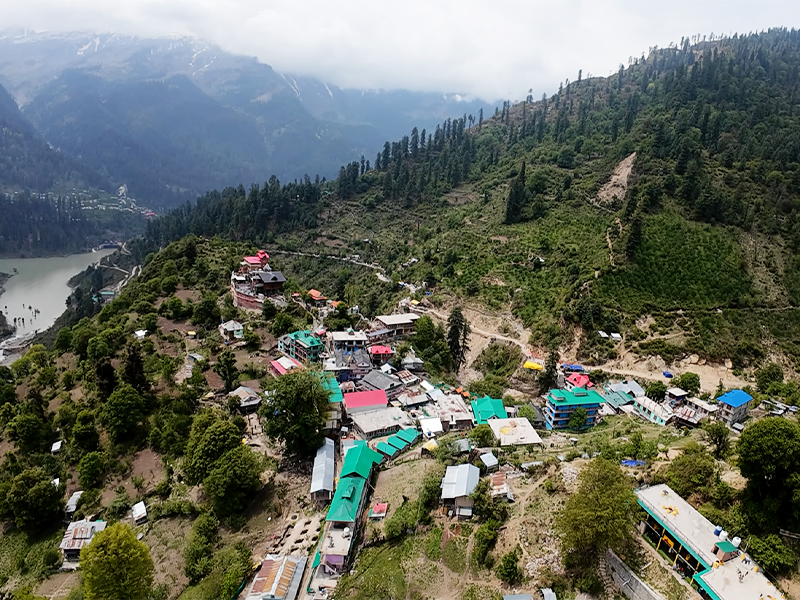


Tosh Village, tucked away in the upper reaches of Parvati Valley, was once a quiet farming settlement. In the early 2000s, it began to appear on the radar of backpackers, nature lovers, and spiritual seekers due to its untouched Himalayan views and proximity to Kheerganga and Pin Parvati Pass.
The village slowly transformed into a hippie paradise with bohemian cafes, wooden homestays, and a steady flow of global t ...
Thermals, jackets, gloves (even in summer, nights are cold).
Comfortable trekking shoes and poncho or raincoat (monsoon treks).
Sunglasses and woollen socks for early spring/winter visits.
Altitude isn’t extreme, but carry Diamox if you're sensitive.
Keep basic meds for cold, body ache, loose motion, and first aid.
Stay hydrated and rest well on arrival to adjust comfortably.
🌄 Trek to Kheerganga or Animal Pass.
☕ Chill at rooftop cafes with Israeli, Indian, and Himachali food.
🎨 Sketch, write, or journal in peace – it's a perfect creative escape.
🛏️ Stay in wooden cottages or budget hostels for authentic experience.
Try Israeli dishes like Shakshuka and Falafel at Pink Floyd Cafe.
Local Himachali Rajma, red rice, siddu, and Tibetan momos.
Apple pies and herbal teas made with local produce.
April to November is ideal for trekking and pleasant stays.
Tosh Village, tucked away in the upper reaches of Parvati Valley, was once a quiet farming settlement. In the early 2000s, it began to appear on the radar of backpackers, nature lovers, and spiritual seekers due to its untouched Himalayan views and proximity to Kheerganga and Pin Parvati Pass.
The village slowly transformed into a hippie paradise with bohemian cafes, wooden homestays, and a steady flow of global travelers. Tosh retained its rustic charm while offering a taste of freedom and solitude. The local community, mostly of the Parvati tribe, still practices agriculture and apple cultivation.
Tosh is also known for its wooden Himachali homes, traditional lifestyle, and panoramic views of snow-capped peaks like Papasura and White Sail. Its location above Barshaini makes it the final road-connected village in Parvati Valley, after which only trekkable routes exist.
Today, Tosh is considered both a spiritual detox hub and a cultural pocket where tradition and traveler spirit blend seamlessly. Despite rising tourism, the village remains peaceful, with no ATMs, phone signals, or traffic — just raw nature and peace.
🛤️ Last Motorable Village in Parvati Valley
Tosh is the final village accessible by road in the Parvati region. Beyond Tosh, trekking trails like Kheerganga and Pin Parvati Pass begin.
🏔️ Altitude Over 7,800 ft
Perched at around 2,400 meters (7,874 ft), Tosh offers breathtaking views of Himalayan peaks and glacier-fed rivers from nearly every rooftop café.
🏠 Traditional Wooden Homes
Villagers still live in multi-level wooden homes built to withstand snow and earthquakes, showcasing authentic Himachali architecture.
🍎 Known for Apple Orchards
Tosh has rich apple farming heritage. In late summer, orchards bloom, and you can try fresh apples straight from the trees.
📶 No Mobile Signal
Tosh has limited to no network coverage, making it a perfect digital detox spot for peace-seekers.
☕ Café Culture With a View
The village is dotted with chill cafes, some run by locals and others by global travelers who decided to stay for good.
🧘♀️ Popular Among Backpackers & Yogis
With low-cost living, yoga spots, and clean mountain air, it attracts both spiritual wanderers and budget explorers.
🌿 Starting Point for Treks
Treks to Kheerganga, Animal Pass, and Sara Umga begin from or pass through Tosh, making it a hub for adventure.
The Traveler Who Stayed Forever
A French traveler named Louis visited Tosh in 2011 for a weekend trek. Moved by its serenity, he returned the next season — and never left. Today, Louis co-owns a popular cafe, teaches yoga to villagers, and speaks fluent Himachali. Locals fondly call him “foreign bhaiya.” His story reflects Tosh’s magic — a place that embraces wanderers as family.
The Winter That Froze Everything But Smiles
In 2019, a record snowfall left Tosh cut off for 5 days. No electricity, no way in or out — yet locals shared food, wood, and even laughter with stranded tourists. It became a tale of human warmth amid Himalayan cold.
A valley is a low-lying area between hills or mountains, often formed by the erosion of water or glaciers. Valleys are characterized by their U-shaped or V-shaped profiles and can contain rivers, streams, and fertile land.